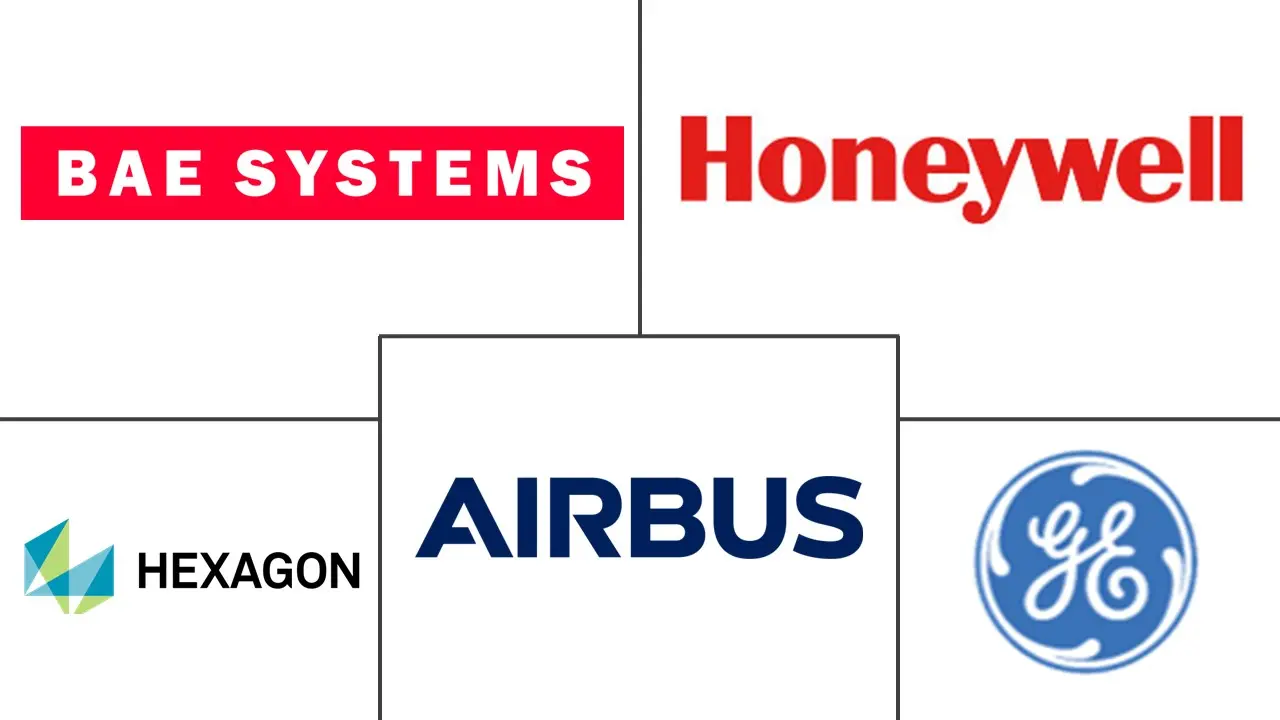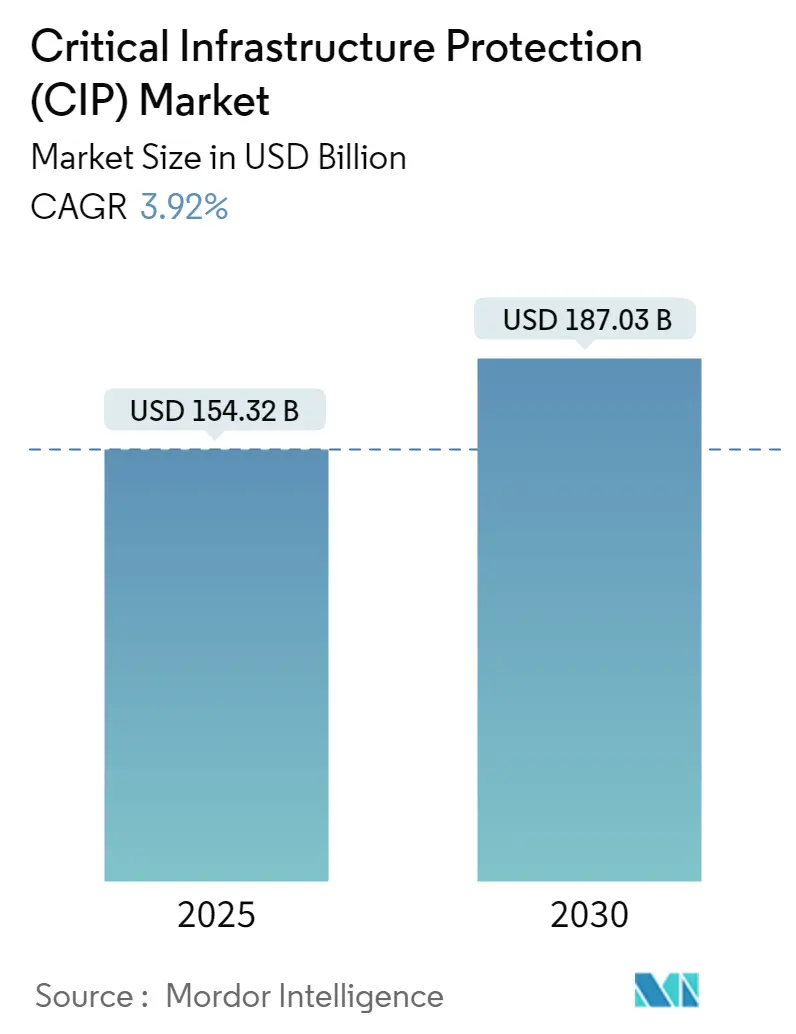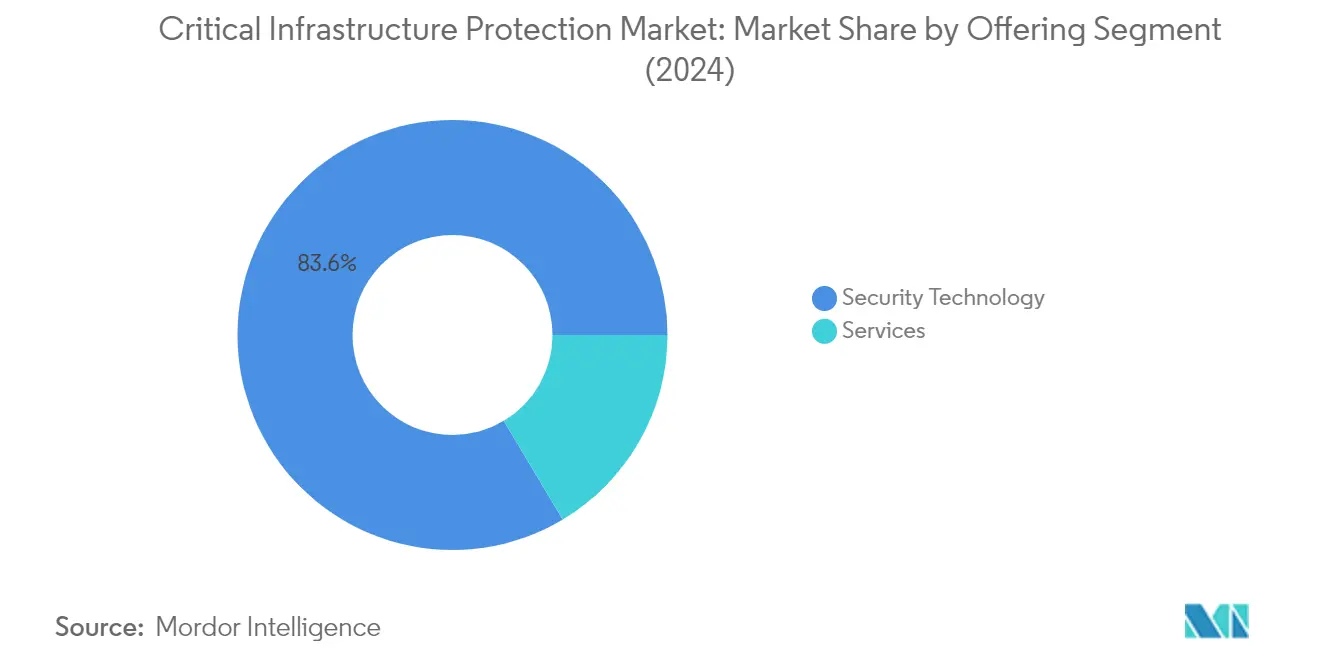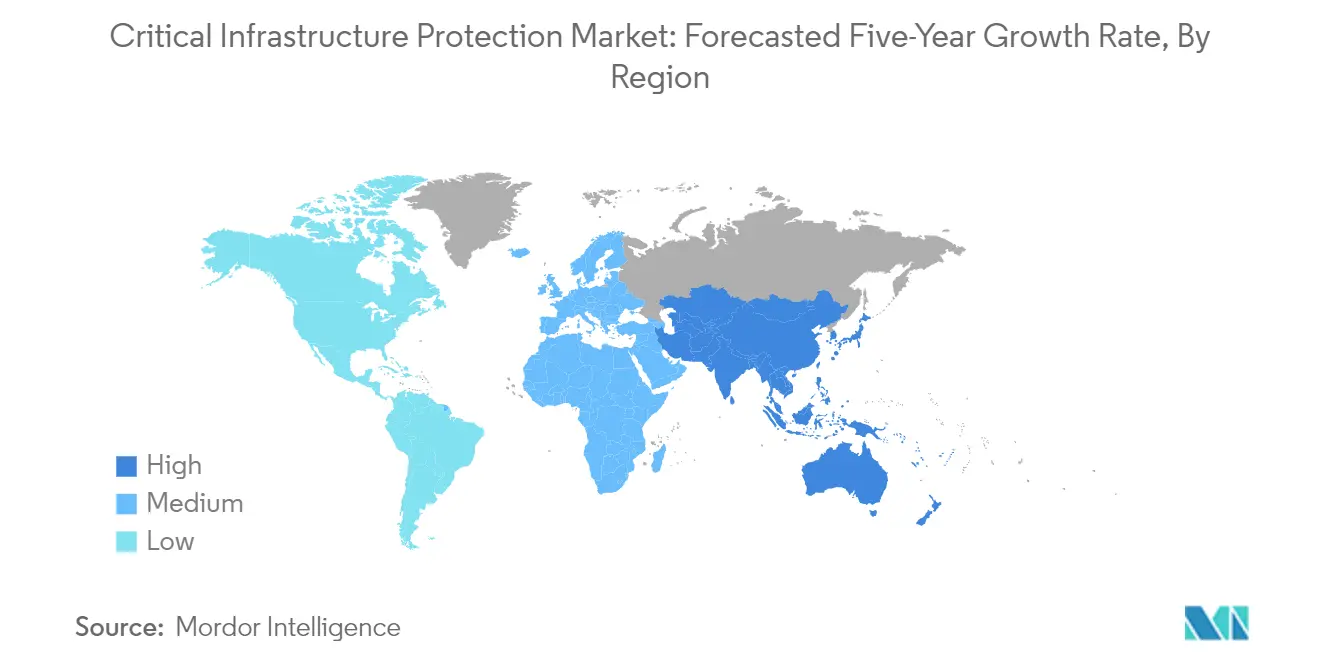Critical Infrastructure Protection (CIP) Market Analysis
The Critical Infrastructure Protection Market size is estimated at USD 154.32 billion in 2025, and is expected to reach USD 187.03 billion by 2030, at a CAGR of 3.92% during the forecast period (2025-2030).
The critical infrastructure protection landscape is experiencing unprecedented challenges as digital transformation reshapes traditional security paradigms. According to IBM Security's 2023 report, the global average data breach cost reached $4.45 million, with critical infrastructure industries experiencing costs exceeding $5 million per incident. The convergence of operational technology security (OT) and information technology (IT) has created new vulnerabilities across sectors, particularly in energy, transportation, and healthcare systems. This integration, while improving operational efficiency, has expanded the attack surface and necessitated more sophisticated protection mechanisms.
The transportation and logistics sector has emerged as a crucial focus area for critical infrastructure protection, with airports and maritime facilities implementing advanced security solutions. In September 2023, Abu Dhabi International Airport's new Midfield Terminal Building implemented AI-powered video analytics technology through Ispotek, demonstrating the sector's commitment to cutting-edge security measures. The integration of artificial intelligence and machine learning capabilities has become essential for real-time threat detection and response, particularly in high-traffic transportation hubs where traditional security measures are insufficient.
The energy sector's vulnerability to cyber threats has intensified, with the U.S. Department of Energy reporting a 70% increase in physical security incidents of electricity infrastructure in 2022 compared to the previous three years. This surge has prompted unprecedented cooperation between nations, exemplified by the October 2023 U.S.-UAE infrastructure cybersecurity cooperation agreement focusing on protecting critical financial sector infrastructure. The agreement represents a growing recognition of the need for international collaboration in protecting critical assets.
The evolution of threat landscapes has necessitated a more coordinated approach to critical infrastructure protection. In March 2023, the EU and NATO launched a dedicated Task Force on Resilience of Critical Infrastructure, focusing on energy, digital infrastructure, transport, and space sectors. This initiative demonstrates the shift toward multi-stakeholder collaboration in addressing complex security challenges. The financial services sector has particularly benefited from this approach, with new frameworks being developed to protect against sophisticated cyber threats targeting payment systems and financial market infrastructure.
Segment Analysis: By Offering
Security Technology Segment in Critical Infrastructure Protection Market
The Security Technology segment dominates the Critical Infrastructure Protection market, holding approximately 84% market share in 2024, equivalent to USD 129.50 billion. This substantial market presence is attributed to the increasing adoption of advanced security technologies across various critical infrastructure sectors, including energy, transportation, and sensitive enterprises. The segment encompasses crucial solutions such as network security, physical security, vehicle identification management, building management systems, secure communications, radars, SCADA security, and CBRNE protection. The widespread implementation of these technologies is driven by the growing complexity of cyber threats, physical security challenges, and the need for comprehensive protection of vital infrastructure assets. Organizations are increasingly investing in integrated security technology solutions to ensure robust protection against evolving threats while maintaining operational efficiency.
Services Segment in Critical Infrastructure Protection Market
The Services segment is experiencing the fastest growth in the Critical Infrastructure Protection market, with a projected growth rate of approximately 8% from 2024 to 2029. This accelerated growth is driven by the increasing demand for specialized services such as risk management, design and integration consultation, managed services, and maintenance support. Organizations are recognizing the importance of professional services in implementing and maintaining complex security solutions effectively. The growth is further fueled by the rising need for expert guidance in navigating complex regulatory requirements, conducting security assessments, and developing comprehensive security strategies. The segment's expansion is also supported by the growing trend of outsourcing security operations to specialized service providers who can offer advanced threat detection, incident response, and continuous monitoring capabilities.
Segment Analysis: Vertical
Sensitive Infrastructure and Enterprises Segment in Critical Infrastructure Protection Market
The Sensitive Infrastructure and Enterprises segment dominates the Critical Infrastructure Protection market, accounting for approximately 39% of the total market share in 2024. This segment encompasses critical assets like telecommunications networks, data centers, internet infrastructure, financial services, and healthcare facilities. The segment's leadership position is driven by the increasing digitalization of essential services and the growing need to protect sensitive data and operations from both cyber and physical threats. The segment is also experiencing the fastest growth trajectory, with organizations increasingly investing in advanced security solutions to protect their critical assets. This growth is particularly evident in the adoption of cloud computing, IoT integration, and the implementation of comprehensive cybersecurity frameworks across various industries. The financial services sector within this segment has shown particular strength in adopting advanced security measures, while healthcare facilities are rapidly upgrading their information systems and digital health records security protocols.
Energy and Power Segment in Critical Infrastructure Protection Market
The Energy and Power segment represents a crucial component of Critical Infrastructure Protection, encompassing power generation facilities, transmission networks, and distribution systems. This segment has witnessed substantial growth due to the increasing modernization of power grids and the integration of renewable energy sources. The segment's expansion is driven by regulatory compliance requirements, such as the North American Electric Reliability Corporation (NERC) Critical Infrastructure Protection (CIP) standards, which mandate robust security measures for electrical energy supply and delivery systems. The implementation of smart grid technologies and the growing focus on cybersecurity in power infrastructure have further accelerated the adoption of protection solutions in this sector. Additionally, the increasing investments in renewable energy infrastructure and the need to secure these assets have contributed significantly to the segment's growth trajectory.
Transportation Segment in Critical Infrastructure Protection Market
The Transportation segment plays a vital role in the Critical Infrastructure Protection market, encompassing aviation, maritime, rail, and road transportation systems. This segment focuses on securing transportation networks and infrastructure against both physical and cyber threats. The increasing digitalization of transportation systems, including the implementation of smart transportation solutions and automated systems, has heightened the need for robust security measures. The segment has seen significant developments in areas such as vehicle identification management, access control systems, and integrated security solutions for transportation hubs. Maritime and aviation sectors, in particular, have demonstrated strong adoption of advanced security technologies to protect their infrastructure and ensure safe operations.
Critical Infrastructure Protection Market Geography Segment Analysis
Critical Infrastructure Protection Market in North America
North America represents a mature critical infrastructure protection market, driven by advanced technological adoption and robust regulatory frameworks. The United States and Canada have established comprehensive approaches to protecting vital infrastructure sectors, including energy, transportation, and sensitive enterprises. Both countries maintain a strong focus on cybersecurity measures and physical security solutions, while emphasizing public-private partnerships in safeguarding critical assets. The region's market is characterized by significant investments in innovative security technologies and the presence of major solution providers.
Critical Infrastructure Protection Market in United States
The United States dominates the North American critical infrastructure protection landscape with approximately 82% market share in 2024. The country's robust approach encompasses various sectors, from energy and power to transportation and defense facilities. The Department of Homeland Security (DHS) and the Cybersecurity and Infrastructure Security Agency (CISA) play vital roles in protecting these systems from cyber threats. The United States electricity segment contains more than 6,413 power plants with approximately 1,075 gigawatts of installed generation. The energy and power industry across the United States is experiencing significant uptake of RADAR security technologies to safeguard critical assets, highlighting the importance of energy infrastructure security.
Critical Infrastructure Protection Market Growth Trajectory in United States
The United States is projected to maintain its growth momentum with an expected CAGR of around 3% during 2024-2029. The country's growth is supported by continuous investments in advanced security solutions and emerging technologies. The Department of Transportation is leading federal initiatives to revamp the country's infrastructure with a major focus on integrating cybersecurity through significant investments under the Bipartisan Infrastructure Law. The implementation of sophisticated security measures across various critical infrastructure sectors, coupled with increasing adoption of AI and machine learning technologies, positions the United States as a key market for innovative protection solutions, underscoring the critical infrastructure protection market growth.
Critical Infrastructure Protection Market in Europe
Europe demonstrates a strong commitment to critical infrastructure protection through comprehensive regulatory frameworks and technological advancement. The region encompasses diverse markets, including Germany, the United Kingdom, France, and Italy, each contributing uniquely to the overall market landscape. The European Union's initiatives for cybersecurity and physical infrastructure protection create a cohesive approach across member states, while individual countries maintain their specific security priorities and implementation strategies.
Critical Infrastructure Protection Market in United Kingdom
The United Kingdom leads the European market with approximately 23% market share in 2024. The country's approach to critical infrastructure protection is characterized by robust cybersecurity measures and comprehensive physical security implementations. The Center for the Protection of National Infrastructure (CPNI) takes the lead in advising critical infrastructure companies on protecting their assets in various sectors, including energy, transportation, and other vital industries. The UK's focus on emerging technologies and digital transformation has strengthened its position in the critical infrastructure protection market.
Critical Infrastructure Protection Market Growth Trajectory in Germany
Germany exhibits the highest growth potential in Europe with an anticipated CAGR of around 6% during 2024-2029. The country's growth is driven by significant investments in securing critical infrastructure across various sectors. The Federal Transport Infrastructure Plan (FTIP) demonstrates Germany's commitment to developing secure and smart transportation infrastructure. The country's emphasis on Industry 4.0 adoption and the integration of advanced technologies in critical infrastructure protection creates a strong foundation for sustained market expansion, contributing to the overall critical infrastructure protection market growth.
Critical Infrastructure Protection Market in Asia-Pacific
The Asia-Pacific region represents a dynamic critical infrastructure protection market, characterized by rapid technological adoption and increasing security awareness. Countries like China, Japan, and India are making significant strides in protecting their critical infrastructure assets. The region's diverse economic landscape and varying levels of technological maturity create unique opportunities and challenges in implementing comprehensive protection measures.
Critical Infrastructure Protection Market in China
China leads the Asia-Pacific region in critical infrastructure protection implementation. The country's approach encompasses various sectors, from energy and power to transportation and digital infrastructure. According to the Cybersecurity Law, Critical Information Infrastructure (CII) protection is paramount, covering sectors such as automotive, aviation, energy, financial services, healthcare, infrastructure, mining, public utilities, and telecommunications. The country's robust regulatory framework and increasing focus on technological sovereignty strengthen its position in the market.
Critical Infrastructure Protection Market Growth Trajectory in India
India emerges as the fastest-growing market in the Asia-Pacific region. The country's growth is driven by increasing digitalization and the government's focus on securing critical infrastructure sectors. The National Critical Infrastructure Information Protection Center, aided by India's Computer Emergency Response Team, the National Cyber Coordination Center, and various central and state cybersecurity agencies, plays a crucial role in the country's infrastructure security framework. The implementation of comprehensive cybersecurity measures and physical protection systems positions India for sustained market expansion in the critical infrastructure industry.
Critical Infrastructure Protection Market in Latin America
Latin America's critical infrastructure protection market demonstrates growing maturity with Brazil, Argentina, and Mexico leading the regional developments. The region focuses on enhancing security measures across energy, transportation, and sensitive infrastructure sectors. Brazil emerges as the largest market, benefiting from modernization initiatives in the energy sector and enhanced security protocols. Mexico shows the fastest growth potential, driven by increasing investments in securing critical assets and implementing advanced protection measures across various sectors.
Critical Infrastructure Protection Market in Middle East & Africa
The Middle East & Africa region exhibits strong potential in critical infrastructure protection, with countries like Saudi Arabia, United Arab Emirates, South Africa, and Turkey making significant investments in securing their critical assets. The region's focus spans across oil and gas infrastructure, power generation facilities, and transportation networks. Saudi Arabia maintains its position as the largest market in the region, while the United Arab Emirates demonstrates the fastest growth trajectory, driven by smart city initiatives and comprehensive cybersecurity frameworks, highlighting the importance of infrastructure security.
Critical Infrastructure Protection (CIP) Market Overview
Top Companies in Critical Infrastructure Protection Market
The critical infrastructure protection market features prominent players like BAE Systems, Honeywell International, Airbus SE, Hexagon AB, General Electric, McAfee, and Lockheed Martin leading the innovation curve. These critical infrastructure protection companies are increasingly focusing on developing integrated solutions that combine physical and cyber security capabilities to address evolving threats. Strategic partnerships and collaborations with technology providers have become a key trend, particularly in areas of AI, machine learning, and cloud security integration. Companies are expanding their geographical presence through local partnerships and establishing regional centers of excellence to better serve critical infrastructure needs across different regions. Product innovation is largely centered around developing autonomous and connected ecosystem solutions, with an emphasis on real-time threat detection and response capabilities. Operational agility is being enhanced through investments in digital transformation initiatives and the adoption of software-defined security architectures.
Market Structure Shows Dynamic Competitive Environment
The critical infrastructure protection market exhibits a mix of global conglomerates and specialized security solution providers, creating a diverse competitive landscape. Large multinational corporations leverage their extensive resources and established relationships with government agencies to maintain market dominance, while specialized players carve out niches through focused expertise in specific security domains. The market demonstrates moderate consolidation, with major players actively pursuing strategic acquisitions to expand their technological capabilities and market reach. Recent years have witnessed increased merger and acquisition activities, particularly targeting companies with advanced cybersecurity capabilities and innovative technologies in areas such as IoT security and industrial control systems protection.
The competitive dynamics are further shaped by the presence of regional players who possess strong local market knowledge and established relationships with domestic critical infrastructure operators. These companies often serve as strategic partners for global players seeking to expand their presence in specific regions. The market has seen a trend of vertical integration, with companies acquiring capabilities across the security value chain to offer end-to-end solutions. This has led to the emergence of comprehensive solution providers who can address both physical and cyber security needs of critical infrastructure operators.
Innovation and Adaptability Drive Market Success
Success in the critical infrastructure protection market increasingly depends on companies' ability to deliver integrated, scalable solutions that address both current and emerging security challenges. Incumbent players are focusing on strengthening their technological capabilities through significant investments in research and development, particularly in areas such as artificial intelligence, machine learning, and advanced analytics. Market leaders are also emphasizing the development of customizable solutions that can be adapted to specific industry requirements while maintaining compliance with evolving regulatory standards. Building strong relationships with government agencies and regulatory bodies has become crucial, as it provides early insights into policy changes and helps shape industry standards.
For contenders looking to gain critical infrastructure protection market share, specialization in specific vertical markets or security domains offers a viable path to growth. Success factors include developing innovative solutions that address unique challenges in sectors such as energy, transportation, or healthcare. The ability to demonstrate a clear value proposition through enhanced security capabilities, cost-effectiveness, and operational efficiency is crucial for gaining customer trust. Companies must also consider the increasing importance of cybersecurity regulations and compliance requirements across different regions, as these factors significantly influence customer decision-making. The market shows relatively high end-user concentration in government and large enterprise segments, making relationship building and long-term service capabilities critical success factors.
Critical Infrastructure Protection (CIP) Market Leaders
-
Bae Systems PLC
-
Honeywell International Inc.
-
Airbus SE
-
Hexagon AB
-
General Electric Company
- *Disclaimer: Major Players sorted in no particular order
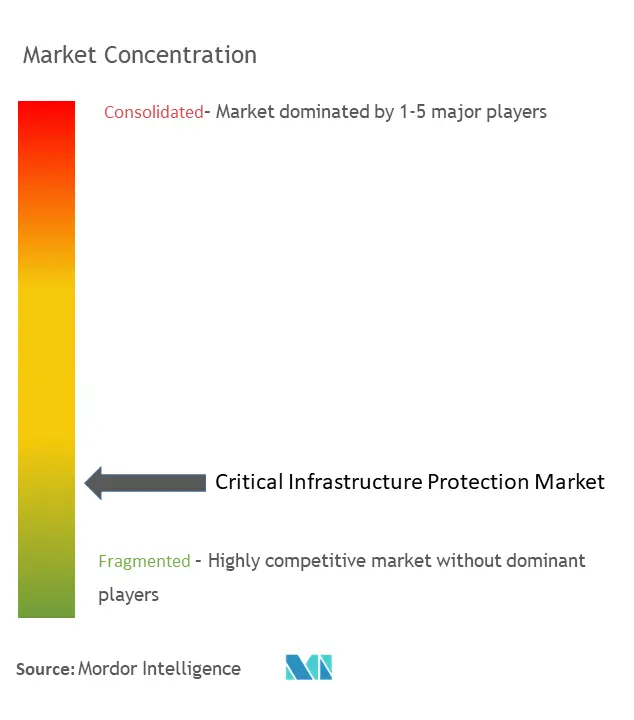
Critical Infrastructure Protection (CIP) Market News
- October 2023 - GHD Digital announced the launch of its Cyber Critical Infrastructure and Risk Centre of Excellence (CoE), designed to protect organizations, their critical systems, and sensitive information from the growing threat of cyber-attacks.
- May 2023 - The U.S. Cybersecurity & Infrastructure Security Agency (CISA) revealed the Ransomware Vulnerability Warning Pilot (RVWP) program to help secure critical infrastructure organizations that can protect their systems from ransomware attacks. The RVWP pilot aims to keep agencies updated on possible attack targets so their security teams can act accordingly.
Critical Infrastructure Protection (CIP) Market Report - Table of Contents
1. INTRODUCTION
- 1.1 Study Assumptions and Market Definition
- 1.2 Scope of the Study
2. RESEARCH METHODOLOGY
3. EXECUTIVE SUMMARY
4. MARKET INSIGHTS
- 4.1 Market Overview
-
4.2 Industry Attractiveness - Porter's Five Forces Analysis
- 4.2.1 Bargaining Power of Suppliers
- 4.2.2 Bargaining Power of Buyers
- 4.2.3 Threat of New Entrants
- 4.2.4 Threat of Substitutes
- 4.2.5 Degree of Competition
- 4.3 An Assessment of the Impact of COVID-19 on the Market
- 4.4 Use Case Analysis- By End-Users
5. MARKET DYNAMICS
-
5.1 Market Drivers
- 5.1.1 Enormous Investments in Smart Grid Technology
- 5.1.2 Physical Threats, Cyber Threats, and Insider Attacks
- 5.1.3 Joint Functioning of Cloud Computing and Critical Infrastructure Protection
- 5.1.4 Political Pressures for Better Regulations and Implementations
-
5.2 Market Restraints
- 5.2.1 Poor Understanding of Industrial Control Systems
- 5.2.2 Lack of Interoperability Between Products
-
5.3 Market Opportunities
- 5.3.1 IoT Driving the Information and Physical Security Market
6. MARKET SEGMENTATION
-
6.1 By Offering
- 6.1.1 Security Technology
- 6.1.1.1 Network Security
- 6.1.1.2 Physical Security
- 6.1.1.2.1 Screening and Scanning
- 6.1.1.2.2 Video Surveillance
- 6.1.1.2.3 PSIM and PIAM
- 6.1.1.2.4 Access Control
- 6.1.1.3 Vehicle Identification Management
- 6.1.1.4 Building Management Systems
- 6.1.1.5 Secure Communications
- 6.1.1.6 Radars
- 6.1.1.7 SCADA Security
- 6.1.1.8 CBRNE
-
6.2 By Services
- 6.2.1 Risk Management Services
- 6.2.2 Designing, Integration, and Consultation
- 6.2.3 Managed Services
- 6.2.4 Maintenance and Support
-
6.3 By Vertical
- 6.3.1 Energy and Power
- 6.3.2 Transportation
- 6.3.3 Sensitive Infrastructure and Enterprises
-
6.4 By Geography***
- 6.4.1 North America
- 6.4.1.1 United States
- 6.4.1.2 Canada
- 6.4.2 Europe
- 6.4.2.1 Germany
- 6.4.2.2 United Kingdom
- 6.4.2.3 France
- 6.4.2.4 Italy
- 6.4.3 Asia
- 6.4.3.1 China
- 6.4.3.2 Japan
- 6.4.3.3 India
- 6.4.4 Australia and New Zealand
- 6.4.5 Latin America
- 6.4.5.1 Brazil
- 6.4.5.2 Argentina
- 6.4.5.3 Mexico
- 6.4.6 Middle East and Africa
- 6.4.6.1 United Arab Emirates
- 6.4.6.2 Saudi Arabia
- 6.4.6.3 South Africa
- 6.4.6.4 Turkey
7. VENDOR MARKET SHARE ANALYSIS
8. COMPETITIVE LANDSCAPE
-
8.1 Company Profiles*
- 8.1.1 BAE Systems PLC
- 8.1.2 Honeywell International Inc.
- 8.1.3 Airbus SE
- 8.1.4 Hexagon AB
- 8.1.5 General Electric Company
- 8.1.6 McAfee Corp.
- 8.1.7 Waterfall Security Solutions
- 8.1.8 General Dynamics Corporation
- 8.1.9 Lockheed Martin Corporation
- 8.1.10 Northrop Grumman Corp.
- 8.1.11 Kaspersky Lab Inc.
- 8.1.12 Ericsson AB
9. INVESTMENT ANALYSIS
10. FUTURE OF THE MARKET
Critical Infrastructure Protection (CIP) Market Industry Segmentation
Critical infrastructure is the vigilance and response to serious incidents that involve the key infrastructure of a region, nation, or organization. The rising need to protect sensitive infrastructures from attacks is leading to the adoption of critical infrastructure protection solutions. Critical infrastructure protection provides controls to stabilize the device, secure communication between devices, and manage and monitor the connected devices. It is adapted to control the threat of cybercrime and physical tampering with the key infrastructure.
The critical infrastructure protection market estimates the revenue accrued from security technology solutions and services across the various end-use industries such as energy and power, transportation, and sensitive infrastructure and enterprises. The study also provides the current market scenario and outlook of the critical infrastructure protection market across various key countries considered under the scope. The study includes an in-depth analysis of the competitive landscape of the key critical infrastructure protection vendors operating in the region.
The critical infrastructure protection market is segmented by security technology (network security, physical security [screening & scanning, video surveillance, PSIM & PIAM, access control], vehicle identification management, building management systems, secure communications, radars, SCADA security, and CBRNE), services (risk management services, designing, integration, and consultation, managed services, maintenance & support), vertical (energy & power, transportation, sensitive infrastructure and enterprises), and geography (North America [United States, Canada], Europe [Germany, United Kingdom, France, Italy, Rest of Europe], Asia Pacific [China, Japan, India, Rest of Asia Pacific], Latin America [Brazil, Argentina, Mexico, Rest of Latin America], Middle East and Africa [United Arab Emirates, Saudi Arabia, South Africa, Turkey, Rest of Middle East and Africa]). The market sizes and forecasts are provided in terms of value in (USD) for all the segments.
| By Offering | Security Technology | Network Security | ||
| Physical Security | Screening and Scanning | |||
| Video Surveillance | ||||
| PSIM and PIAM | ||||
| Access Control | ||||
| Vehicle Identification Management | ||||
| Building Management Systems | ||||
| Secure Communications | ||||
| Radars | ||||
| SCADA Security | ||||
| CBRNE | ||||
| By Services | Risk Management Services | |||
| Designing, Integration, and Consultation | ||||
| Managed Services | ||||
| Maintenance and Support | ||||
| By Vertical | Energy and Power | |||
| Transportation | ||||
| Sensitive Infrastructure and Enterprises | ||||
| By Geography*** | North America | United States | ||
| Canada | ||||
| Europe | Germany | |||
| United Kingdom | ||||
| France | ||||
| Italy | ||||
| Asia | China | |||
| Japan | ||||
| India | ||||
| Australia and New Zealand | ||||
| Latin America | Brazil | |||
| Argentina | ||||
| Mexico | ||||
| Middle East and Africa | United Arab Emirates | |||
| Saudi Arabia | ||||
| South Africa | ||||
| Turkey | ||||
Critical Infrastructure Protection (CIP) Market Research FAQs
How big is the Critical Infrastructure Protection Market?
The Critical Infrastructure Protection Market size is expected to reach USD 154.32 billion in 2025 and grow at a CAGR of 3.92% to reach USD 187.03 billion by 2030.
What is the current Critical Infrastructure Protection Market size?
In 2025, the Critical Infrastructure Protection Market size is expected to reach USD 154.32 billion.
Who are the key players in Critical Infrastructure Protection Market?
Bae Systems PLC, Honeywell International Inc., Airbus SE, Hexagon AB and General Electric Company are the major companies operating in the Critical Infrastructure Protection Market.
Which is the fastest growing region in Critical Infrastructure Protection Market?
Asia Pacific is estimated to grow at the highest CAGR over the forecast period (2025-2030).
Which region has the biggest share in Critical Infrastructure Protection Market?
In 2025, the North America accounts for the largest market share in Critical Infrastructure Protection Market.
What years does this Critical Infrastructure Protection Market cover, and what was the market size in 2024?
In 2024, the Critical Infrastructure Protection Market size was estimated at USD 148.27 billion. The report covers the Critical Infrastructure Protection Market historical market size for years: 2019, 2020, 2021, 2022, 2023 and 2024. The report also forecasts the Critical Infrastructure Protection Market size for years: 2025, 2026, 2027, 2028, 2029 and 2030.
Our Best Selling Reports
Critical Infrastructure Protection (CIP) Market Research
Mordor Intelligence provides comprehensive market analysis and industry outlook for the critical infrastructure protection market, offering detailed insights into market size, growth trends, and competitive landscape. Our industry research encompasses crucial segments like perimeter security, infrastructure security, and operational technology security, delivering valuable data on market leaders, emerging technologies, and strategic developments. The report pdf includes in-depth market forecasts, segmentation analysis, and detailed assessment of critical infrastructure cybersecurity solutions and infrastructure resilience strategies.
Our consulting expertise extends beyond traditional market research to provide strategic insights for critical infrastructure protection stakeholders. We offer technology scouting services to identify emerging solutions in scada security and infrastructure cybersecurity, conduct comprehensive regulatory assessments for critical infrastructure security regulations, and perform detailed competition assessment of critical infrastructure protection companies. Our team specializes in analyzing customer needs and behavior patterns, evaluating product positioning strategies, and providing actionable intelligence for new product launches in the critical infrastructure security space. Through advanced data analytics and visualization techniques, we help clients navigate the complex landscape of critical infrastructure monitoring and protection solutions.

